Image Processing Approach to Investigate the Correlation between Machining Parameters and Burr Formation in Micro-Milling Processes of Selective-Laser-Melted AISI 316L
Abstract
1. Introduction
2. Materials and Methods
2.1. Material, Machining Process, and Measurement System
2.2. Burr Measurement using Image Processing
3. Results and Analysis
4. Conclusions
- ➢
- Burr formation during micro-milling of AISI 316L is not significantly affected by the cutting speed when the feed rate and depth of cut are kept constant.
- ➢
- Decreasing the feed rate and depth of cut while keeping the cutting speed constant leads to a significant reduction in burr formation on both up-milling and down-milling sides due to a decrease in material deformation and displacement.
- ➢
- The burr width on the down-milling side tends to be larger than on the up-milling side due to the continuous chip formation and compressive forces experienced during down-milling.
- ➢
- Increasing the feed rate while holding other parameters constant notably enhances burr formation, suggesting the need for precise control of the feed rate for optimal machining outcomes.
- ➢
- Larger burrs are more likely to occur on the down-milling side, as supported by the measurement of maximum burr widths, thus reinforcing the described burr formation mechanism.
- ➢
- The proposed algorithm in the study can quickly and accurately detect both slot and burr widths for the up- and down-milling sides, surpassing potential human observational errors.
- ➢
- The slot widths smaller than the tool diameter used indicate potential tool wear. This, along with the high burr density, suggests a decrease in tool performance, hinting at the need for improved machining strategies and tool maintenance.
- ➢
- The study’s proposed approach could potentially minimize burr formation by providing a fast and accurate burr formation characterization that could be adapted to a closed-loop system. Future research could focus on refining this method and studying other factors that influence burr formation and tool wear.
Author Contributions
Funding
Data Availability Statement
Conflicts of Interest
References
- DebRoy, T.; Mukherjee, T.; Milewski, J.O.; Elmer, J.W.; Ribic, B.; Blecher, J.J.; Zhang, W. Scientific, technological and economic issues in metal printing and their solutions. Nat. Mater. 2019, 18, 1026–1032. [Google Scholar] [CrossRef]
- Lee, H.; Lim CH, J.; Low, M.J.; Tham, N.; Murukeshan, V.M.; Kim, Y.J. Lasers in additive manufacturing: A review. Int. J. Precis. Eng. Manuf. Green Technol. 2017, 4, 307–322. [Google Scholar] [CrossRef]
- Gu, D.D.; Meiners, W.; Wissenbach, K.; Poprawe, R. Laser additive manufacturing of metallic components: Materials, processes and mechanisms. Int. Mater. Rev. 2012, 57, 133–164. [Google Scholar] [CrossRef]
- Jandyal, A.; Chaturvedi, I.; Wazir, I.; Raina, A.; Haq MI, U. 3D printing–A review of processes, materials and applications in industry 4.0. Sustain. Oper. Comput. 2022, 3, 33–42. [Google Scholar] [CrossRef]
- Tao, Y.; Yin, Q.; Li, P. An additive manufacturing method using large-scale wood inspired by laminated object manufacturing and plywood technology. Polymers 2020, 13, 144. [Google Scholar] [CrossRef]
- Lee, J.Y.; An, J.; Chua, C.K. Fundamentals and applications of 3D printing for novel materials. Appl. Mater. Today 2017, 7, 120–133. [Google Scholar] [CrossRef]
- Yi, J.; Zhou, H.; Wei, W.H.; Han, X.C.; Han, D.D.; Gao, B.R. Micro-/nano-structures fabricated by laser technologies for optoelectronic devices. Front. Chem. 2021, 9, 823715. [Google Scholar] [CrossRef]
- Leng, F.; Zheng, M.; Xu, C. 3D-printed microneedles with open groove channels for liquid extraction. Exploration 2021, 1, 20210109. [Google Scholar] [CrossRef] [PubMed]
- Attaran, M. The Rise of 3-D Printing: The Advantages of Additive Manufacturing over Traditional Manufacturing. Bus. Horiz. 2017, 60, 677–688. [Google Scholar] [CrossRef]
- Dutta, B.; Froes, F.H. The Additive Manufacturing (AM) of Titanium Alloys. Met. Powder Rep. 2017, 72, 96–106. [Google Scholar] [CrossRef]
- Karolewska, K.; Ligaj, B.; Wirwicki, M.; Szala, G. Strength Analysis of Ti6Al4V Titanium Alloy Produced by the Use of Additive Manufacturing Method under Static Load Conditions. J. Mater. Res. Technol. 2020, 9, 1365–1379. [Google Scholar] [CrossRef]
- Jin, W.; Zhang, C.; Jin, S.; Tian, Y.; Wellmann, D.; Liu, W. Wire Arc Additive Manufacturing of Stainless Steels: A Review. Appl. Sci. 2020, 10, 1563. [Google Scholar] [CrossRef]
- Selmi, H.; Brousseau, J.; Caron-Guillemette, G.; Goulet, S.; Desjardins, J.; Belzile, C. Weldability of 316L Parts Produced by Metal Additive Manufacturing. J. Manuf. Mater. Process. 2023, 7, 71. [Google Scholar] [CrossRef]
- Bressan, J.; Daros, D.; Sokolowski, A.; Mesquita, R.; Barbosa, C. Influence of hardness on the wear resistance of 17-4 PH stainless steel evaluated by the pin-on-disc testing. J. Tianmater. Process. Technol. 2008, 205, 353–359. [Google Scholar] [CrossRef]
- Greco, S.; Kieren-Ehses, S.; Kirsch, B.; Aurich, J.C. Micro Milling of Additively Manufactured AISI 316L: Impact of the Layerwise Microstructure on the Process Results. Int. J. Adv. Manuf. Technol. 2021, 112, 361–373. [Google Scholar] [CrossRef]
- Silva, M.; Felismina, R.; Mateus, A.; Parreira, P.; Malça, C. Application of a Hybrid Additive Manufacturing Methodology to Produce a Metal/Polymer Customized Dental Implant. Procedia Manuf. 2017, 12, 150–155. [Google Scholar] [CrossRef]
- Chen, Q.; Thouas, G.A. Metallic Implant Biomaterials. Mater. Sci. Eng. R Rep. 2015, 87, 1–57. [Google Scholar] [CrossRef]
- Al-Mamun, N.S.; Mairaj Deen, K.; Haider, W.; Asselin, E.; Shabib, I. Corrosion Behavior and Biocompatibility of Additively Manufactured 316L Stainless Steel in a Physiological Environment: The Effect of Citrate Ions. Addit. Manuf. 2020, 34, 101237. [Google Scholar] [CrossRef]
- Kong, D.; Ni, X.; Dong, C.; Lei, X.; Zhang, L.; Man, C.; Yao, J.; Cheng, X.; Li, X. Bio-Functional and Anti-Corrosive 3D Printing 316L Stainless Steel Fabricated by Selective Laser Melting. Mater. Des. 2018, 152, 88–101. [Google Scholar] [CrossRef]
- Tascioglu, E.; Karabulut, Y.; Kaynak, Y. Influence of Heat Treatment Temperature on the Microstructural, Mechanical, and Wear Behavior of 316L Stainless Steel Fabricated by Laser Powder Bed Additive Manufacturing. Int. J. Adv. Manuf. Technol. 2020, 107, 1947–1956. [Google Scholar] [CrossRef]
- De Assis, C.L.F.; Mecelis, G.R.; Coelho, R.T. An Investigation of Stainless Steel 316L Parts Produced by Powder Bed Fusion Submitted to Micro-Endmilling Operations. Int. J. Adv. Manuf. Technol. 2020, 109, 1867–1880. [Google Scholar] [CrossRef]
- Chae, J.; Park, S.S.; Freiheit, T. Investigation of Micro-Cutting Operations. Int. J. Mach. Tools Manuf. 2006, 46, 313–332. [Google Scholar] [CrossRef]
- Aslantas, K.; Ekici, E.; Çiçek, A. Optimization of Process Parameters for Micro Milling of Ti-6Al-4V Alloy Using Taguchi-Based Gray Relational Analysis. Measurement 2018, 128, 419–427. [Google Scholar] [CrossRef]
- Erçetin, A.; Aslantas, K.; Özgün, Ö. Micro-end milling of biomedical TZ54 magnesium alloy produced through powder metallurgy. Mach. Sci. Technol. 2020, 24, 924–947. [Google Scholar] [CrossRef]
- Chen, Y.; Wang, T.; Zhang, G. Research on Parameter Optimization of Micro-Milling Al7075 Based on Edge-Size-Effect. Micromachines 2020, 11, 197. [Google Scholar] [CrossRef]
- Akkoyun, F.; Ercetin, A.; Aslantas, K.; Pimenov, D.Y.; Giasin, K.; Lakshmikanthan, A.; Aamir, M. Measurement of Micro Burr and Slot Widths through Image Processing: Comparison of Manual and Automated Measurements in Micro-Milling. Sensors 2021, 21, 4432. [Google Scholar] [CrossRef] [PubMed]
- Jung, W.-C.; Heo, Y.-M.; Yoon, G.-S.; Shin, K.-H.; Chang, S.-H.; Kim, G.-H.; Cho, M.-W. Micro Machining of Injection Mold Inserts for Fluidic Channel of Polymeric Biochips. Sensors 2007, 7, 1643. [Google Scholar] [CrossRef]
- Filiz, S.; Xie, L.; Weiss, L.E.; Ozdoganlar, O.B. Micromilling of Microbarbs for Medical Implants. Int. J. Mach. Tools Manuf. 2008, 48, 459–472. [Google Scholar] [CrossRef]
- Li, W.; Liu, M.; Ren, Y.; Chen, Q. A High-Speed Precision Micro-Spindle Use for Mechanical Micro-Machining. Int. J. Adv. Manuf. Technol. 2019, 102, 3197–3211. [Google Scholar] [CrossRef]
- Medeossi, F.; Sorgato, M.; Bruschi, S.; Savio, E. Novel Method for Burrs Quantitative Evaluation in Micro-Milling. Precis. Eng. 2018, 54, 379–387. [Google Scholar] [CrossRef]
- Karakılınç, U.; Ergene, B.; Yalçın, B.; Aslantaş, K.; Erçetin, A. Comparative Analysis of Minimum Chip Thickness, Surface Quality and Burr Formation in Micro-Milling of Wrought and Selective Laser Melted Ti64. Micromachines 2023, 14, 1160. [Google Scholar] [CrossRef]
- Greco, S.; Schmidt, M.; Klauer, K.; Kirsch, B.; Aurich, J.C. Hybrid Manufacturing: Influence of Material Properties during Micro Milling of Different Additively Manufactured AISI 316L. Prod. Eng. 2022, 16, 797–809. [Google Scholar] [CrossRef]
- Liu, C.; Shi, B.; Zhou, J.; Tang, C. Quantification and Characterization of Microporosity by Image Processing, Geometric Measurement and Statistical Methods: Application on SEM Images of Clay Materials. Appl. Clay Sci. 2011, 54, 97–106. [Google Scholar] [CrossRef]
- Hafeez, F.; Almaskari, F. Image Processing for Measuring Damage and Delamination in Glass Reinforced Epoxy. J. Test Eval. 2016, 44, 20150368. [Google Scholar] [CrossRef]
- Akkoyun, F.; Ozcelik, A.; Arpaci, I.; Erçetin, A.; Gucluer, S. A Multi-Flow Production Line for Sorting of Eggs Using Image Processing. Sensors 2022, 23, 117. [Google Scholar] [CrossRef] [PubMed]
- Akkoyun, F.; Ercetin, A. Automated Grain Counting for the Microstructure of Mg Alloys Using an Image Processing Method. J. Mater. Eng. Perform. 2022, 31, 2870–2877. [Google Scholar] [CrossRef]
- Özsoy, K.; Aksoy, B.; Salman, O.K.M. Investigation of the Dimensional Accuracy Using Image Processing Techniques in Powder Bed Fusion. Proc. Inst. Mech. Eng. Part E J. Process Mech. Eng. 2021, 235, 1587–1597. [Google Scholar] [CrossRef]
- Uçak, N.; Outeiro, J.; Aslantas, K.; Çiçek, A.; Çetin, B. Determination of the Friction Coefficients between Uncoated WC-Co Tools and L-PBF and Wrought Ti-6Al-4V Alloys for Micro-Milling Simulations. Procedia CIRP 2023, 117, 281–286. [Google Scholar] [CrossRef]
- Krolczyk, G.M.; Maruda, R.W.; Krolczyk, J.B.; Nieslony, P.; Wojciechowski, S.; Legutko, S. Parametric and Nonparametric Description of the Surface Topography in the Dry and MQCL Cutting Conditions. Measurement 2018, 121, 225–239. [Google Scholar] [CrossRef]
- Hajiahmadi, S. Burr Size Investigation in Micro Milling of Stainless Steel 316L. Int. J. Lightweight Mater. Manuf. 2019, 2, 296–304. [Google Scholar] [CrossRef]
- Balázs, B.Z.; Geier, N.; Takács, M.; Davim, J.P. A Review on Micro-Milling: Recent Advances and Future Trends. Int. J. Adv. Manuf. Technol. 2021, 112, 655–684. [Google Scholar] [CrossRef]
- Jin, S.Y.; Pramanik, A.; Basak, A.K.; Prakash, C.; Shankar, S.; Debnath, S. Burr Formation and Its Treatments—A Review. Int. J. Adv. Manuf. Technol. 2020, 107, 2189–2210. [Google Scholar] [CrossRef]
- Zhang, Z.; Yuan, Z.; Wang, G. Formation and Control Technology of Top Burr in Micro-Milling. MATEC Web Conf. 2017, 108, 04003. [Google Scholar] [CrossRef]
- Chen, W.; Teng, X.; Zheng, L.; Xie, W.; Huo, D. Burr Reduction Mechanism in Vibration-Assisted Micro Milling. Manuf. Lett. 2018, 16, 6–9. [Google Scholar] [CrossRef]
- Yadav, A.K.; Kumar, M.; Bajpai, V.; Singh, N.K.; Singh, R.K. FE Modeling of Burr Size in High- Speed Micro-Milling of Ti6Al4V. Precis. Eng. 2017, 49, 287–292. [Google Scholar] [CrossRef]
- Kumar, P.; Kumar, M.; Bajpai, V.; Singh, N.K. Recent Advances in Characterization, Modeling and Control of Burr Formation in Micro-Milling. Manuf. Lett. 2017, 13, 1–5. [Google Scholar] [CrossRef]
- Aurich, J.C.; Dornfeld, D.; Arrazola, P.J.; Franke, V.; Leitz, L.; Min, S. Burrs—Analysis, Control and Removal. CIRP Ann. 2009, 58, 519–542. [Google Scholar] [CrossRef]
- Dornfeld, D.; Min, S. A Review of Burr Formation in Machining. In Burrs—Analysis, Control and Removal; Springer: Berlin/Heidelberg, Germany, 2010; pp. 3–11. [Google Scholar]
- Ribeiro, K.S.B.; Mariani, F.E.; Coelho, R.T. A Study of Different Deposition Strategies in Direct Energy Deposition (DED) Processes. Procedia Manuf. 2020, 48, 663–670. [Google Scholar] [CrossRef]
- Çevik, Z.A.; Özsoy, K.; Erçetin, A. The Effect of Cutting Length on Burr Width in Micro-Machining of 316l Stainless Steel Produced through Metal Additional Manufacturing. Int. J. 3D Print. Technol. Digit. Ind. 2022, 6, 338–346. [Google Scholar] [CrossRef]
- Cui, D.-D.; Zhang, L.-C. Nano-Machining of Materials: Understanding the Process through Molecular Dynamics Simulation. Adv. Manuf. 2017, 5, 20–34. [Google Scholar] [CrossRef]
- de Oliveira, F.B.; Rodrigues, A.R.; Coelho, R.T.; de Souza, A.F. Size Effect and Minimum Chip Thickness in Micromilling. Int. J. Mach. Tools Manuf. 2015, 89, 39–54. [Google Scholar] [CrossRef]
- Skrzyniarz, M. A Method to Determine the Minimum Chip Thickness during Longitudinal Turning. Micromachines 2020, 11, 1029. [Google Scholar] [CrossRef] [PubMed]
- Kiswanto, G.; Zariatin, D.L.; Ko, T.J. The Effect of Spindle Speed, Feed-Rate and Machining Time to the Surface Roughness and Burr Formation of Aluminum Alloy 1100 in Micro-Milling Operation. J. Manuf. Process. 2014, 16, 435–450. [Google Scholar] [CrossRef]
- Kalyan, C.; Samuel, G.L. Cutting mode analysis in high speed finish turning of AlMgSi alloy using edge chamfered PCD tools. J. Mater. Process. Technol. 2015, 216, 146–159. [Google Scholar] [CrossRef]
- Ahmed, F.; Ahmad, F.; Kumaran, S.T.; Danish, M.; Kurniawan, R.; Ali, S. Development of Cryogenic Assisted Machining Strategy to Reduce the Burr Formation during Micro-Milling of Ductile Material. J. Manuf. Process. 2023, 85, 43–51. [Google Scholar] [CrossRef]
- Bhushan, R.K.; Kumar, S.; Das, S. Effect of Machining Parameters on Surface Roughness and Tool Wear for 7075 Al Alloy SiC Composite. Int. J. Adv. Manuf. Technol. 2010, 50, 459–469. [Google Scholar] [CrossRef]
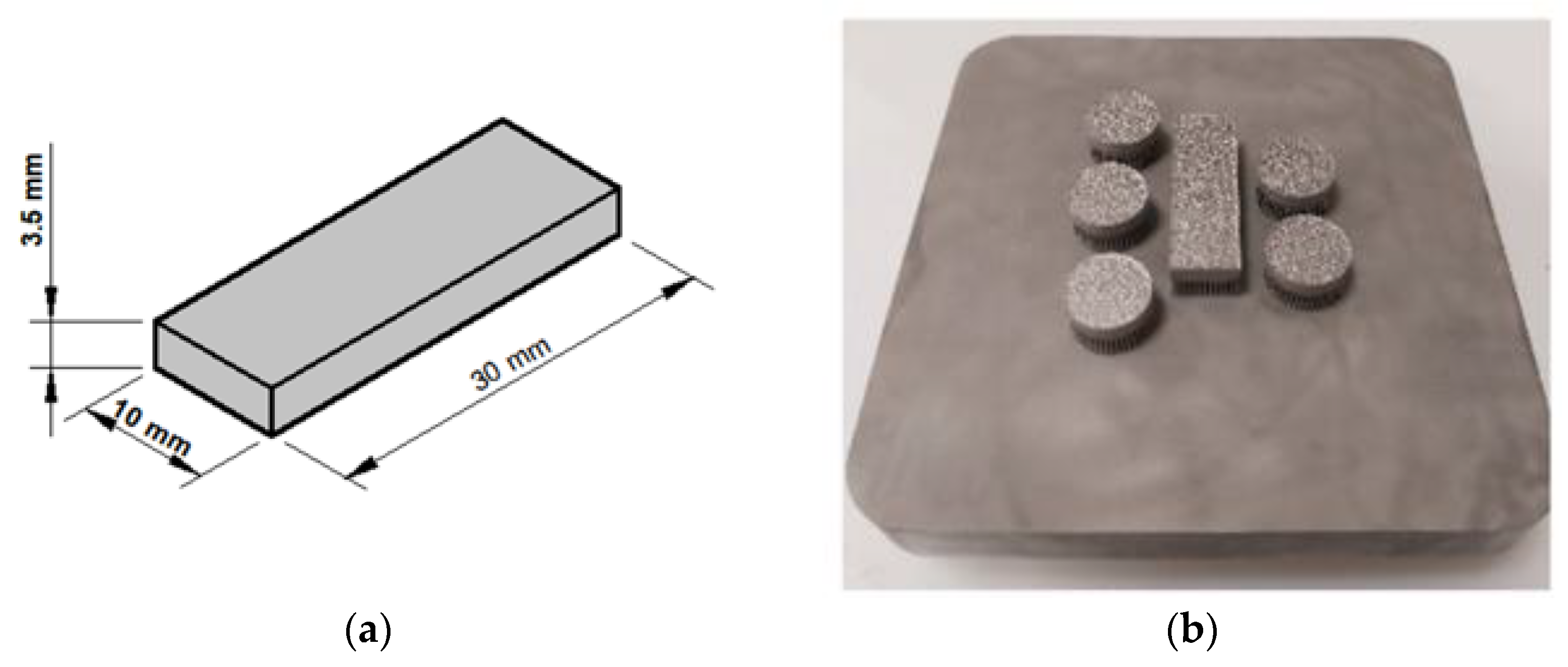
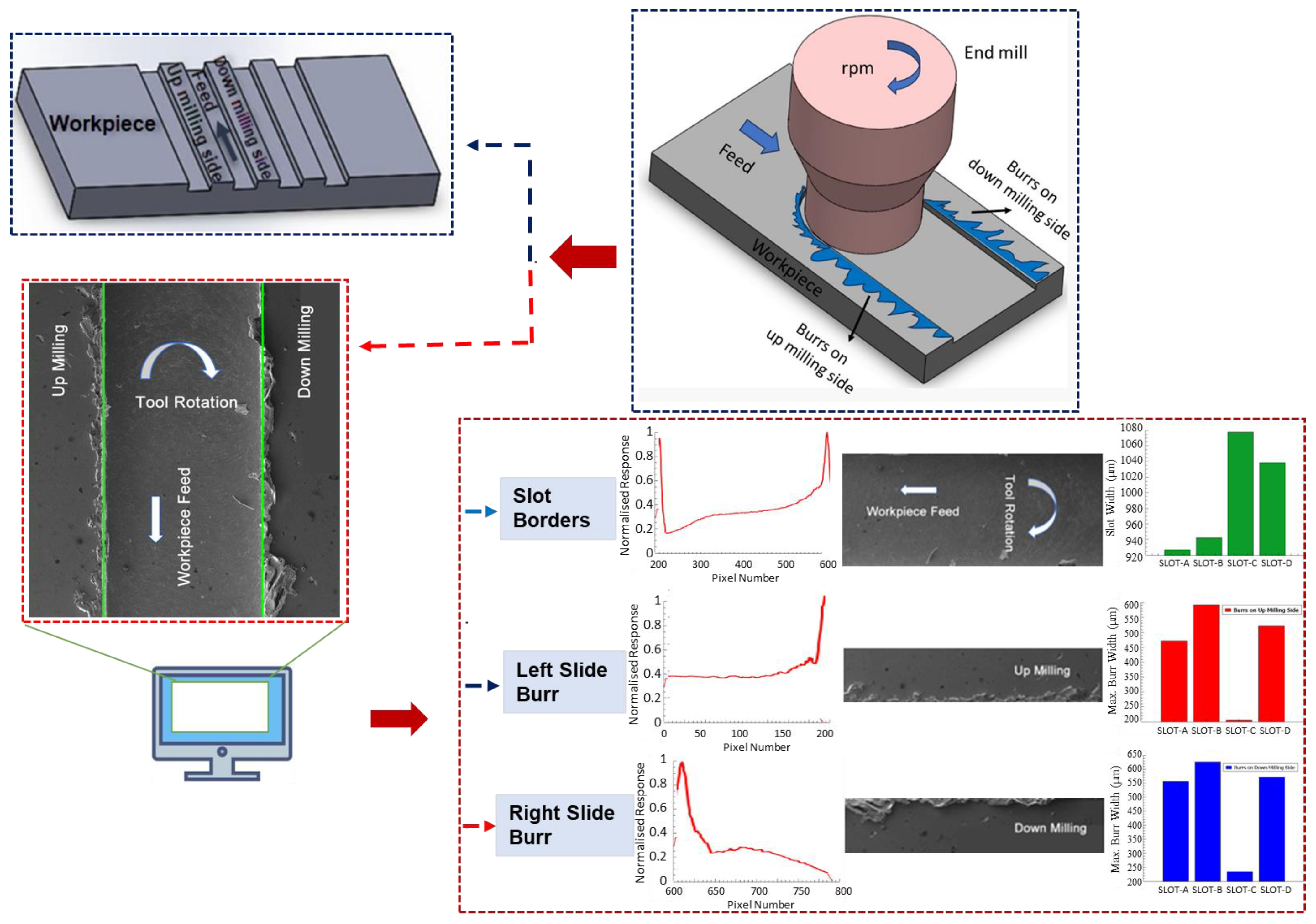
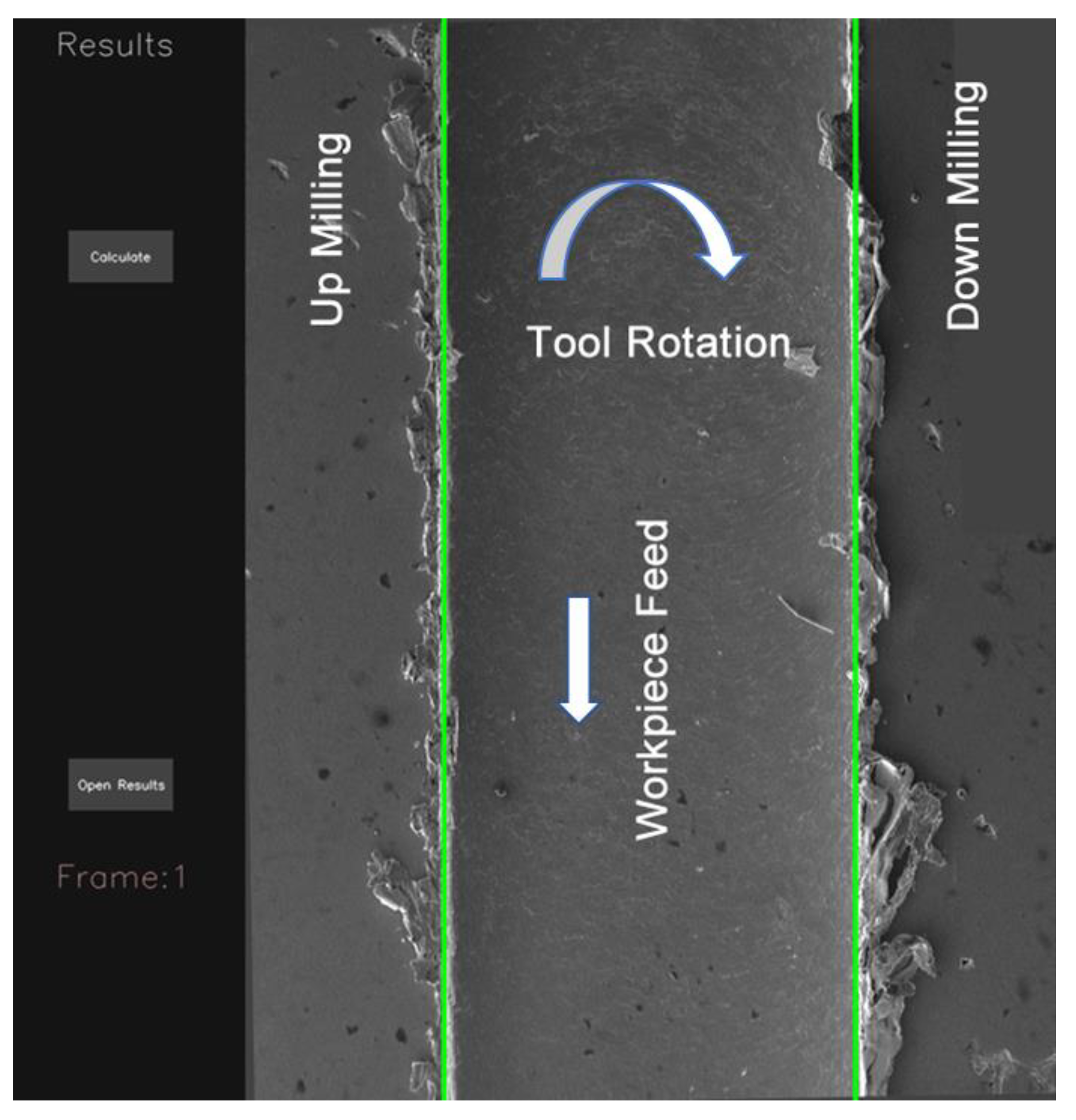
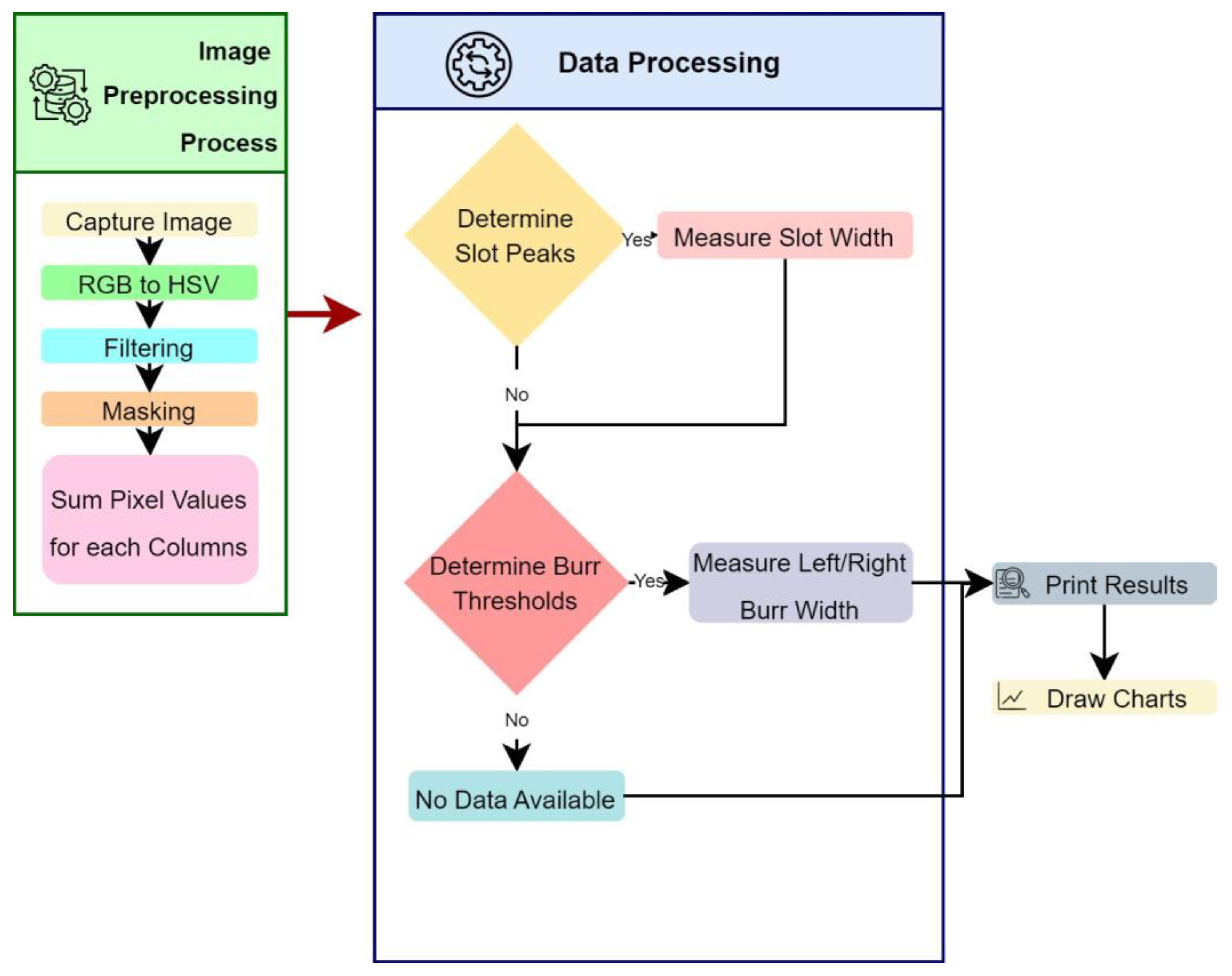

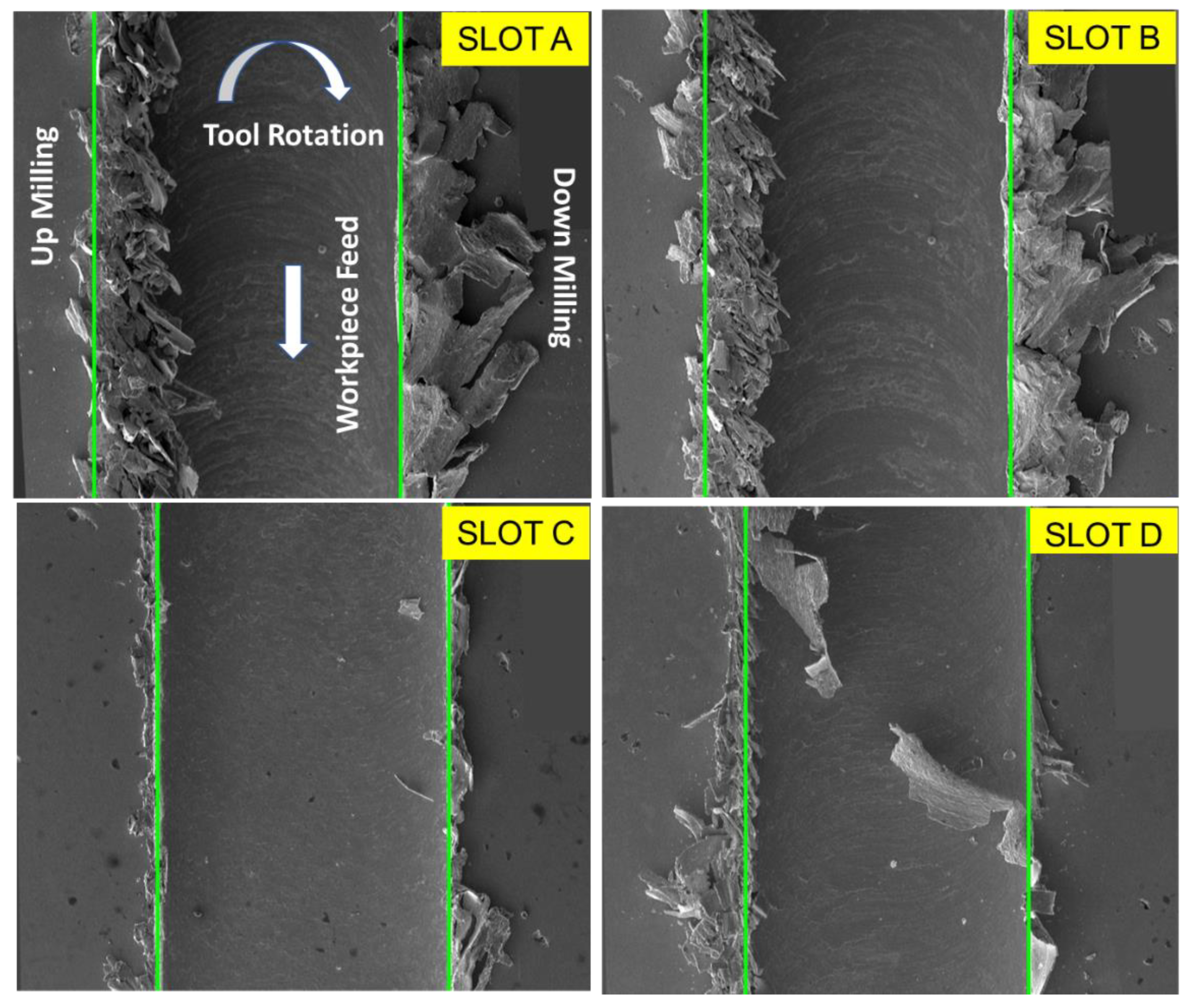
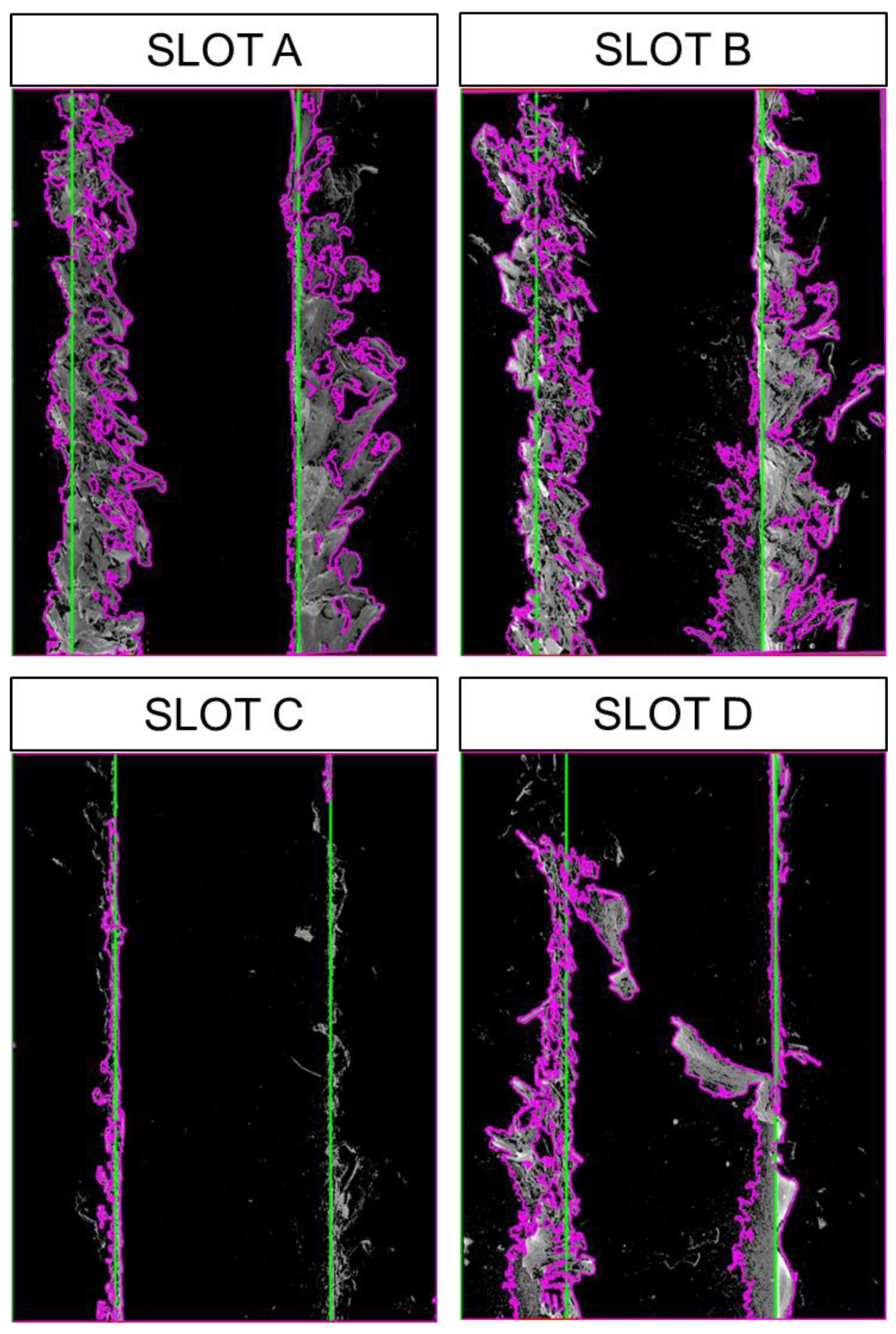

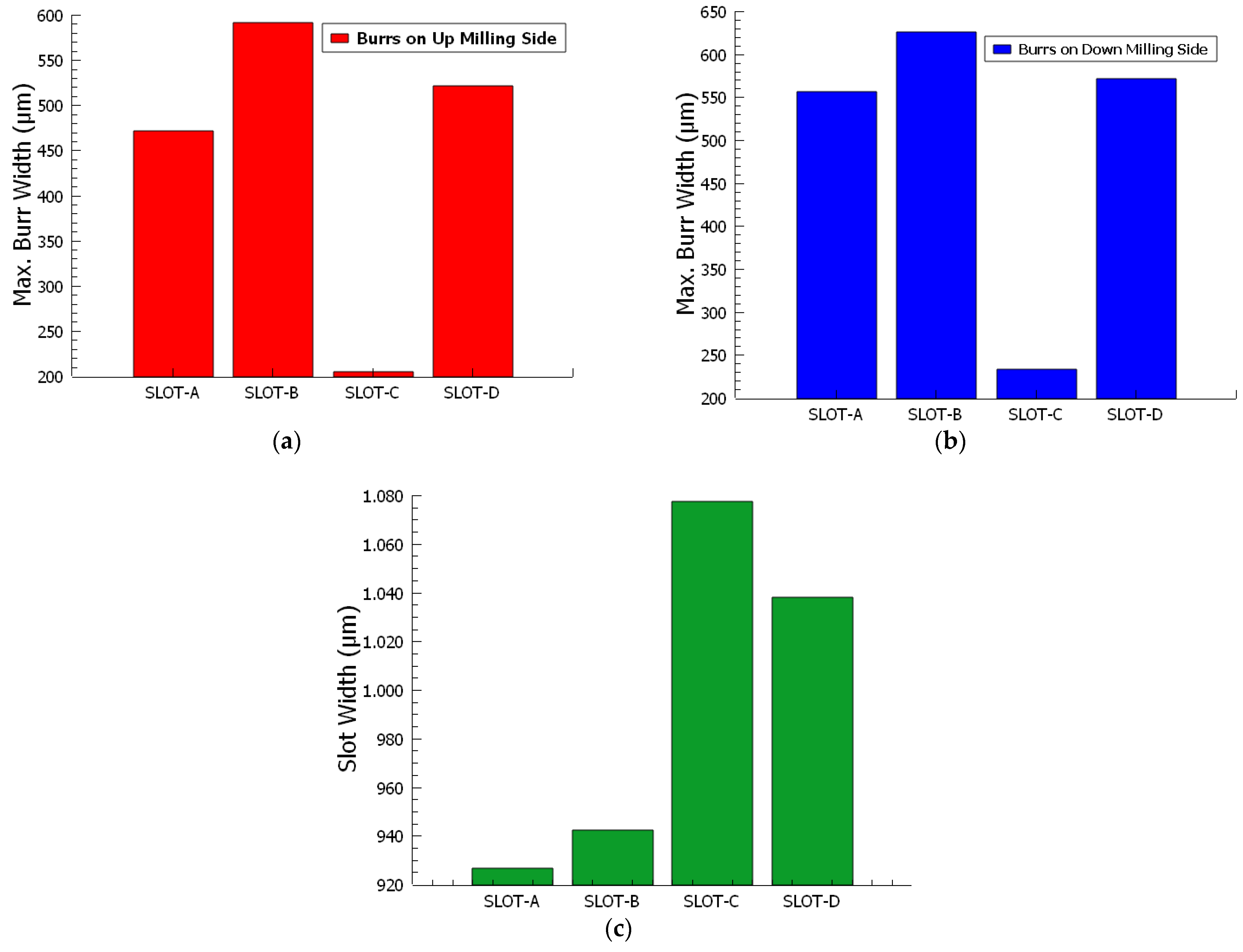
| Element | Cr | Ni | Mo | Mn |
|---|---|---|---|---|
| wt.% | 16.5–18.5 | 10–13 | 2–2.25 | 0–2 |
| Element | Si | P | C | Fe |
| wt.% | 0–1 | 0–0.045 | 0–0.03 | Remain |
| SLOT-CODE | Cutting Speed (m/min) | Feed Rate (mm/min) | Depth of Cut (mm) |
|---|---|---|---|
| SLOT-A | 15.7 | 25 | 0.5 |
| SLOT-B | 31.4 | 25 | 0.5 |
| SLOT-C | 31.4 | 10 | 0.2 |
| SLOT-D | 31.4 | 20 | 0.2 |
Disclaimer/Publisher’s Note: The statements, opinions and data contained in all publications are solely those of the individual author(s) and contributor(s) and not of MDPI and/or the editor(s). MDPI and/or the editor(s) disclaim responsibility for any injury to people or property resulting from any ideas, methods, instructions or products referred to in the content. |
© 2023 by the authors. Licensee MDPI, Basel, Switzerland. This article is an open access article distributed under the terms and conditions of the Creative Commons Attribution (CC BY) license (https://creativecommons.org/licenses/by/4.0/).
Share and Cite
Akkoyun, F.; Cevik, Z.A.; Ozsoy, K.; Ercetin, A.; Arpaci, I. Image Processing Approach to Investigate the Correlation between Machining Parameters and Burr Formation in Micro-Milling Processes of Selective-Laser-Melted AISI 316L. Micromachines 2023, 14, 1376. https://doi.org/10.3390/mi14071376
Akkoyun F, Cevik ZA, Ozsoy K, Ercetin A, Arpaci I. Image Processing Approach to Investigate the Correlation between Machining Parameters and Burr Formation in Micro-Milling Processes of Selective-Laser-Melted AISI 316L. Micromachines. 2023; 14(7):1376. https://doi.org/10.3390/mi14071376
Chicago/Turabian StyleAkkoyun, Fatih, Zihni Alp Cevik, Koray Ozsoy, Ali Ercetin, and Ibrahim Arpaci. 2023. "Image Processing Approach to Investigate the Correlation between Machining Parameters and Burr Formation in Micro-Milling Processes of Selective-Laser-Melted AISI 316L" Micromachines 14, no. 7: 1376. https://doi.org/10.3390/mi14071376
APA StyleAkkoyun, F., Cevik, Z. A., Ozsoy, K., Ercetin, A., & Arpaci, I. (2023). Image Processing Approach to Investigate the Correlation between Machining Parameters and Burr Formation in Micro-Milling Processes of Selective-Laser-Melted AISI 316L. Micromachines, 14(7), 1376. https://doi.org/10.3390/mi14071376








